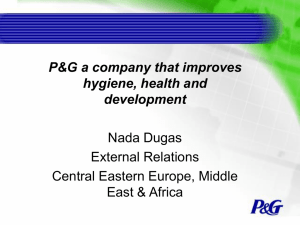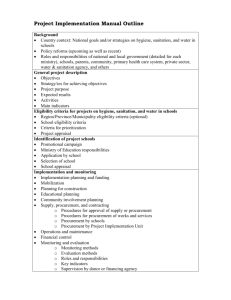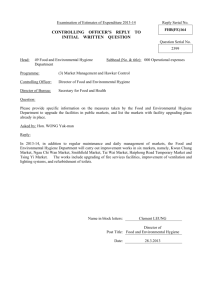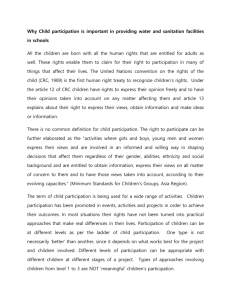NZQA registered unit standard 26292 version 3 Page 1 of 3
advertisement
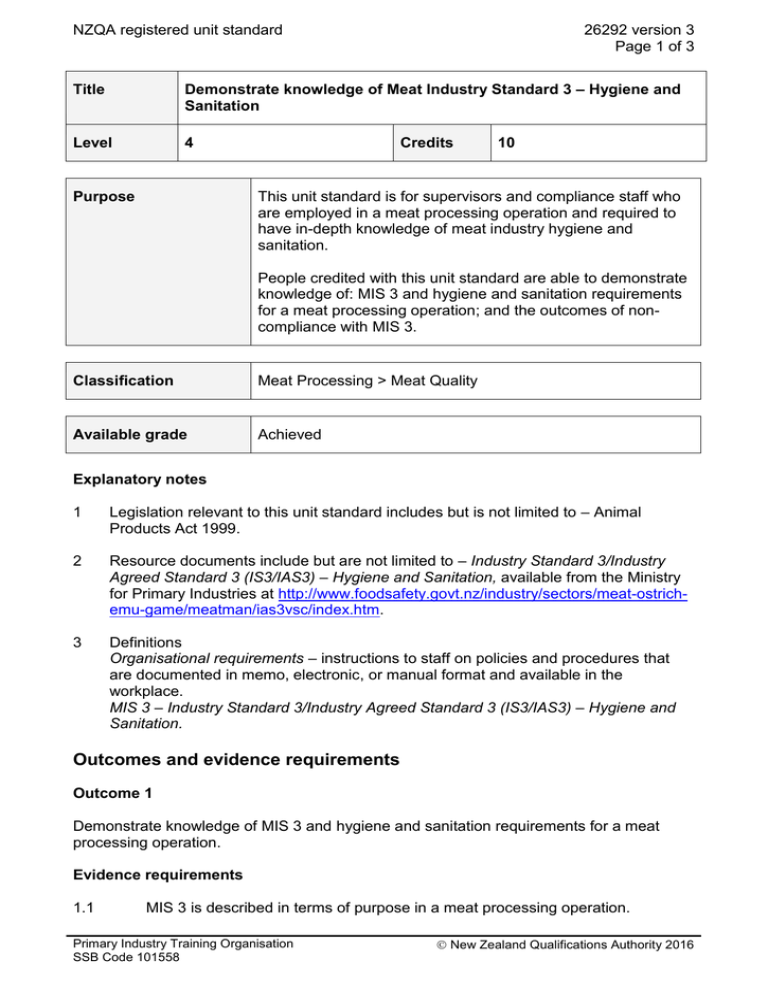
NZQA registered unit standard 26292 version 3 Page 1 of 3 Title Demonstrate knowledge of Meat Industry Standard 3 – Hygiene and Sanitation Level 4 Purpose Credits 10 This unit standard is for supervisors and compliance staff who are employed in a meat processing operation and required to have in-depth knowledge of meat industry hygiene and sanitation. People credited with this unit standard are able to demonstrate knowledge of: MIS 3 and hygiene and sanitation requirements for a meat processing operation; and the outcomes of noncompliance with MIS 3. Classification Meat Processing > Meat Quality Available grade Achieved Explanatory notes 1 Legislation relevant to this unit standard includes but is not limited to – Animal Products Act 1999. 2 Resource documents include but are not limited to – Industry Standard 3/Industry Agreed Standard 3 (IS3/IAS3) – Hygiene and Sanitation, available from the Ministry for Primary Industries at http://www.foodsafety.govt.nz/industry/sectors/meat-ostrichemu-game/meatman/ias3vsc/index.htm. 3 Definitions Organisational requirements – instructions to staff on policies and procedures that are documented in memo, electronic, or manual format and available in the workplace. MIS 3 – Industry Standard 3/Industry Agreed Standard 3 (IS3/IAS3) – Hygiene and Sanitation. Outcomes and evidence requirements Outcome 1 Demonstrate knowledge of MIS 3 and hygiene and sanitation requirements for a meat processing operation. Evidence requirements 1.1 MIS 3 is described in terms of purpose in a meat processing operation. Primary Industry Training Organisation SSB Code 101558 New Zealand Qualifications Authority 2016 NZQA registered unit standard 26292 version 3 Page 2 of 3 1.2 MIS 3 is described in terms of legislative requirements related to sanitation and hygiene. 1.3 The definition of hygiene and sanitation is explained using industry specific terms. Range 1.4 terms include but are not limited to – clean, contaminant, hygiene, protective clothing, sanitary, sanitation, sanitising, sterilising. The definition of hygiene and sanitation is explained in terms of its elements. Range elements include but are not limited to – maintenance of facilities, establishment and maintenance of a state of hygiene, work practices of personnel, requirements for the hygiene of personnel. 1.5 The effects of having unsound hygiene practices in a meat processing operation are identified. 1.6 The processes for ensuring that hygiene and sanitation requirements are met are identified in terms of organisational requirements. Range 1.7 processes include but are not limited to – surveillance programmes, actioning defects, change to process layout, potable water, plant maintenance, vermin control, pre-operational hygiene, process room atmosphere, processing hygiene, conveying product and by-product, food that comes in contact with non-food contact surfaces, waste management, cleaning programmes, chemicals, dust, odours, fumes and gases, health of personnel, hygienic practices. The technical reasons for MIS 3 are described in terms of a premise’s sanitation, operational hygiene, and hygiene of personnel requirements. Range requirements include but are not limited to – surveillance programmes, actioning defects, change to process layout, potable water, plant maintenance, vermin control, pre-operational hygiene, process room atmosphere, processing hygiene, conveying product and by-product, food that comes in contact with non-food contact surfaces, waste management, cleaning programmes, chemicals, dust, odours, fumes and gases, health of personnel, hygienic practices. Outcome 2 Demonstrate knowledge of the outcomes of non-compliance with MIS 3. Evidence requirements 2.1 Non-compliance with MIS 3 is analysed in terms of its impact and consequences on the product. Primary Industry Training Organisation SSB Code 101558 New Zealand Qualifications Authority 2016 NZQA registered unit standard 2.2 26292 version 3 Page 3 of 3 Corrective and preventative actions are formulated to meet MIS 3 requirements and in accordance with organisational requirements. Replacement information This unit standard replaced unit standard 17683 and unit standard 19452. Planned review date 31 December 2019 Status information and last date for assessment for superseded versions Process Version Date Last Date for Assessment Registration 1 19 March 2010 31 December 2018 Review 2 27 January 2015 N/A Revision 3 17 September 2015 N/A Consent and Moderation Requirements (CMR) reference 0033 This CMR can be accessed at http://www.nzqa.govt.nz/framework/search/index.do. Please note Providers must be granted consent to assess against standards (accredited) by NZQA, before they can report credits from assessment against unit standards or deliver courses of study leading to that assessment. Industry Training Organisations must be granted consent to assess against standards by NZQA before they can register credits from assessment against unit standards. Providers and Industry Training Organisations, which have been granted consent and which are assessing against unit standards must engage with the moderation system that applies to those standards. Requirements for consent to assess and an outline of the moderation system that applies to this standard are outlined in the Consent and Moderation Requirements (CMR). The CMR also includes useful information about special requirements for organisations wishing to develop education and training programmes, such as minimum qualifications for tutors and assessors, and special resource requirements. Comments on this unit standard Please contact the Primary Industry Training Organisation standards@primaryito.ac.nz if you wish to suggest changes to the content of this unit standard. Primary Industry Training Organisation SSB Code 101558 New Zealand Qualifications Authority 2016
